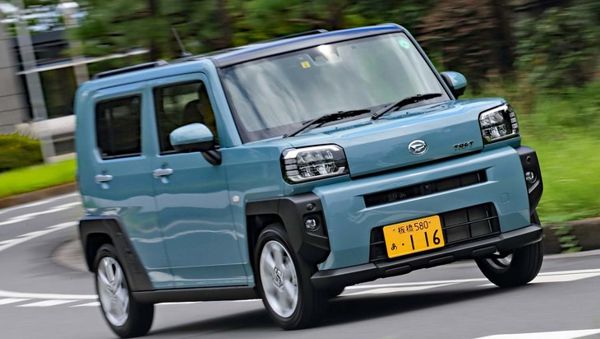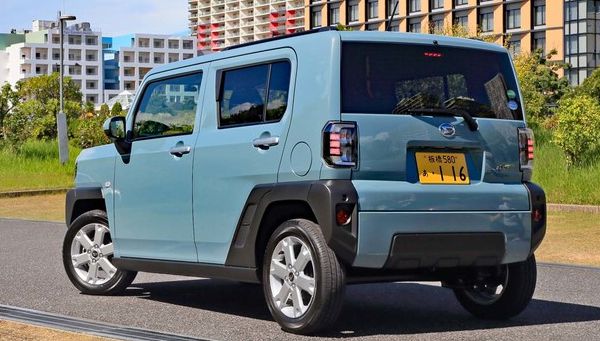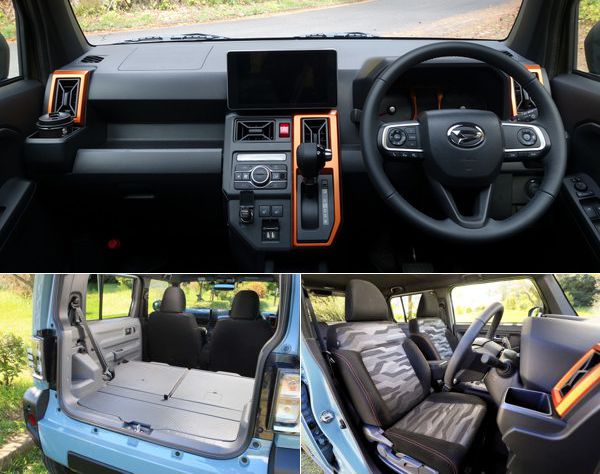Published
on 10
Oct 2021
|
All rights reserved.
|
|
|

|
|
It
takes Daihatsu 6 years to come up with a response to Suzuki Hustler.
|
|
7 years ago, Suzuki
introduced a ground-breaking SUV-style K-car called Hustler. It looked
extremely cute, felt rugged yet was just as practical and economical to
run as conventional K-cars. Envying its success, Daihatsu followed suit
and created Taft, although that was 6 years later.
Like Hustler but not Jimny, the Taft is not a real offroader. Still,
its 190mm ride height, large approach and departure angles lend it a
certain level of offroadability, even though the wheels are only
15-inch. While Hustler looks cute, the Daihatsu looks more purposeful.
A blocky shape, angular fenders, a high waistline, relatively lower
roof (that’s 50mm lower than Hustler), small windows and thicker
C-pillar end up in a mini-Hummer appearance. Undoubtedly, its target
buyers are male without children. Not necessarily young men, maybe also
those with kids grown up, and for sure they have to love outdoor
activities like camping, fishing, mountain-biking etc.

|
|
High
waistline, low roofline, small windows and thick C-pillars give a
mini-Hummer look.
|
|
The underpinnings are shared with other Daihatsu K-cars, of course. It
is built on the so-called DNGA (Daihatsu New Global Architecture)
platform which was introduced by Tanto a year ago. Using more
high-strength steel to construct its body-and-white, it is guaranteed
to be stiffer yet lighter, with improved NVH suppression. The engines,
however, are unchanged from older Daihatsu K-cars. This means a
naturally aspirated 3-cylinder with 52 horsepower or turbocharged
version with 64 horsepower. They are relatively weak and unrefined
compared with some rivals. The NA engine pairs with a conventional CVT,
but turbo gets a brand-new dual-mode CVT (D-CVT), which uses belt-type
CVT for low speed and switch over to a planetary gearset from medium to
high speed. The chief advantage of this arrangement is a much wider
ratio spread, which improves fuel economy. Otherwise, the Taft is quite
conventional.
The interior design is just as angular and rugged as its exterior, and
I have to say its dashboard looks a bit like a Land Rover. The
combination of high seating and a relatively low roofline would have
resulted in a claustrophobic feel, but fortunately, Daihatsu equips it
with standard panoramic glass roof right above the front seats, which
makes the cabin far more light and airy. The front seats are
comfortable. The rear bench is not so good. While legroom is
reasonable, the seat itself is hard and uncomfortable, and there is a
transmission tunnel running beneath. The small rear windows make it
feel more cramped than it is, as the glass roof does not cover the rear
bench. Moreover, the rear seat does not slide, unlike Hustler, so you
cannot adjust the allocation between passenger and luggage space. On
the plus side, it folds flat to form a large load platform, and the
plastic surface is rugged and easy to clean.

|
|
The
cabin focuses on front seats, as the car targets at couples without
children.
|
|
The suspension tuning is quite good. It is a little stiffer than the
norm of Daihatsu, but still absorbs impact competently, thanks to
generous suspension travel. The steering is heavier, too. Although it
transfers no feel to your hands, it doesn’t kickback on rough surfaces
either. Body control is reasonable for this kind of vehicle. Cornering
at faster paces will lead to pronounced body roll, but it remains
stable.
Although the Taft is not too heavy, Daihatsu’s naturally aspirated
engine is best to be avoided, because it takes a life time to overtake
slower cars, if any, on highway. The scream you heard when the CVT revs
the breathless motor under acceleration is close to unbearable.
Turbocharged engine is a lot more relaxing and refined. Even when
travelling at 60 mph, it doesn’t feel strained, thanks to the D-CVT as
well. On the downside, fuel economy drops quickly as you go faster.
The Taft is a good effort, but it trails Hustler in a number of key
areas: styling, rear seat comfort and versatility, performance of base
engine and fuel economy. The Suzuki is not only more versatile but also
easier to attract female buyers. That is why it still outsells the
Daihatsu follower.
|
Verdict:    |
|